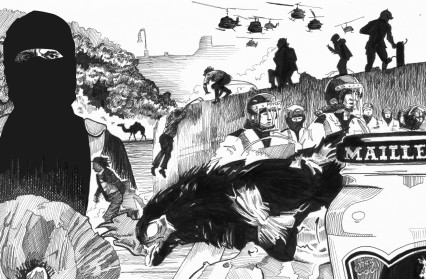Kate North writes both fiction and poetry. She is the author of the novel, Eva Shell (Cinnamon Press, 2008) and a poetry collection, Bistro (Cinnamon Press, 2012). Her stories and poetry have been widely published in a range of anthologies and magazines, including The Lonely Crowd, The Lampeter Review, Two Thirds North, and Secondary Character. She also edits for various publications while teaching Creative Writing at Cardiff Metropolitan University.
Kate’s story ‘The New Tent’ is part of Wales Arts Review’s Story: Retold series and I had a conversation with her about the decisions behind writing ‘The New Tent’.
Durre S. Mughal: Hi, Kate. Why did you choose ‘The Lost Fisherman’ by Margiad Evans to reinterpret? Were you previously familiar with Evans’ works?
 Kate North: I chose ‘The Lost Fisherman’ for a number of reasons. Firstly, it is an excellent short story. In terms of atmosphere it achieves a strange and tense stasis, which I guess reflects the reality of living through war. And while Evans describes things in a naturalistic way there is also the hint of the surreal or the uneasy, to my mind anyway. I also really like the image of the lost fisherman who appears and disappears throughout the story, almost like a hallucination. He could represent various conflicting ideas or feelings: unfulfilled potential, being at ease with one’s environment, isolation, hope, shock, loss. So, I was interested in the way Evans used him as a recurring motif. On top of this I had been trying to write about war for some time but hadn’t found the right vehicle yet. The fact that we are living through wars but not experiencing them. Our involvement in war is very real and yet often very remote. And then, finally, I wanted to write something in response to a female author from the anthology we were asked to choose from. Story: The Library of Wales Short Story Anthology, Volume 1 actually only has a handful of stories by women writers. I don’t really think that represents the reality of the publishing landscape it attempts to reflect. So, I decided to respond to a female author as a matter of principle if you like.
Kate North: I chose ‘The Lost Fisherman’ for a number of reasons. Firstly, it is an excellent short story. In terms of atmosphere it achieves a strange and tense stasis, which I guess reflects the reality of living through war. And while Evans describes things in a naturalistic way there is also the hint of the surreal or the uneasy, to my mind anyway. I also really like the image of the lost fisherman who appears and disappears throughout the story, almost like a hallucination. He could represent various conflicting ideas or feelings: unfulfilled potential, being at ease with one’s environment, isolation, hope, shock, loss. So, I was interested in the way Evans used him as a recurring motif. On top of this I had been trying to write about war for some time but hadn’t found the right vehicle yet. The fact that we are living through wars but not experiencing them. Our involvement in war is very real and yet often very remote. And then, finally, I wanted to write something in response to a female author from the anthology we were asked to choose from. Story: The Library of Wales Short Story Anthology, Volume 1 actually only has a handful of stories by women writers. I don’t really think that represents the reality of the publishing landscape it attempts to reflect. So, I decided to respond to a female author as a matter of principle if you like.
One of the things that instantly stands out is the way that ‘The New Tent’ begins. The repetitive lines of poetry almost mimic a child’s nursery rhyme. While the structure of it instantly places the story as a contemporary response to Evans’. Talk us through your intentions and thoughts behind this.
I wanted to establish the theme of families and relationships early on. I saw this as a very simple and direct way of doing so. The rhyme is childlike because I wanted to convey that the simple narratives we have for our lives are often established in childhood. Also, that these hopes and plans can be cultural norms, as are the ways in which we remember and mark conflict or loss. Matters of life and death are ritualised and I find the ways in which we do this interesting.
Margiad Evans’ story is quite evocative and full of naturalistic imagery. There is also a feeling of domesticity and recollection of memories, and I can see this reflected in your response. Was it a challenge to reinterpret this?
Not really, I didn’t see my story as a direct response to Evans’s, more that I took her text as a jumping off point for some ideas that I wanted to explore. Obviously I am writing from a different time and place to Evans and my story will reflect this.
What I particularly like about the ‘The New Tent’ is the way that you have depicted war contrasted with the ‘normality’ of everyday life but through the news and the world war montages on the screen. Talk us through this process.
I was interested in the way that Evans depicted everyday life in the context of war. I wanted to explore these ideas from the here and now. I have been thinking about how we are still in a state of war but that the nature of war has changed. Conflict seeps into our lives very unlike the Evans story. But nevertheless, it’s still part of our daily lives, our cultural positioning in the world. I am interested in the way technology has changed the way we communicate and engage in conflict and hence the way we understand it.
Talking about your own work… You write in various forms – short stories, novels, poetry. When we last spoke you also mentioned working on your next novel. Do you think the different mediums and structures of writing compliment each other? How do you find the transition between each of them?
I’ve always written in a variety of forms. I look for the form to suit the subject, not the other way around. That’s just how I go about it. So, I will want to write about X and for one reason or another I will know that it is a story, not a poem, and then I will know it is a short story, not a novel. There are commonalities with forms. I think, like lots of people, that the poem and the short story have very much in common, structurally speaking but in terms of register and image also. Novels are just so much more roomy and sprawling so they allow you to tackle complex ideas at length and with great depth. I am working on a novel but it will be a long time coming. I am slow. I’ve also started another poetry collection and I’m trying to finish a story collection. I don’t recommend this approach though, but again, it’s just the way I work. I always have to have more than one thing on the burner. The novel is going to take a long while but hopefully the others will come sooner.
How would you say you have developed as a writer since Eva Shell? In terms of form, Eva Shell was quite multi-layered and fragmented. Do you find you still write in this style?
Well, again, that form suited the story. I was trying to piece together a life in a way that reflected the world around Eva. So, no, I haven’t written anything like that since. But I find ordering collections to be a similar structural exercise. What you place where and why. What a poem or story sits next to can really change how the reader views it.
What authors and texts are you influenced by with regards to your work?
I’m a huge fan of Ali Smith. I think her writing is extremely exciting and I love the way she continues to push the novel form. There is a great sense of play with her writing. I’m very much enjoying the work of David Mitchell too. I’ve just started The Bone Clocks. I’ve recently discovered a mid twentieth century writer called Anna Kavan and it has felt a little like coming home. Her sense of dislocation creates an eerie sort of beauty that I find fascinating. In the poetry world I have just read and very much enjoyed Kate Bingham’s Infragreen. I totally recommend it.
Aside from being a writer, you are also a full-time lecturer and a programme director at Cardiff Metropolitan University. How do you juggle the academic/writer stance in terms of time? What are your writing methods and habits?
Well, in a very practical way I find myself working on longer projects over the summer and Easter holidays. I tend to get up quite early to write in term time. I’m lucky that I can use my research in my teaching. Anna Kavan has just made it to one of my module reading lists for example. I find the variety of my job exciting also. One day I will be teaching and the next I will be at a conference or I will be involved in a research project with academics from other disciplines in other places. I find the variation really inspiring.
What should we look out for next?
I’m hoping to finish a short story collection soon. I’m a good chunk of the way through my poetry collection also, so watch this space…
Illustration by Dean Lewis












